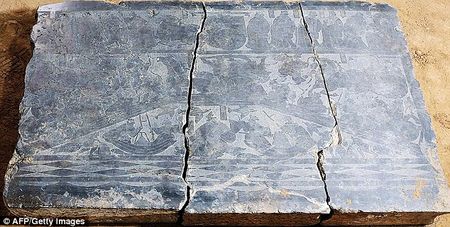China Finds Likely Tomb of 3rd Century General Cao Cao
Part of a possible tomb of Cao Cao, a renowned ruler during the Three Kingdoms period in 208 to 280 A.D. AP Photo
BEIJING (AP).- Chinese archaeologists have found what could be the tomb of Cao Cao, a skillful general and ruler in the 3rd century who was later depicted in popular folklore as the archetypal cunning politician.
Archaeological officials say Cao's 8,000-square feet (740-square meter) tomb complex, with a 130-feet (40-meter) passage leading to an underground chamber, was found in Xigaoxue, a village near the ancient capital of Anyang in central Henan province, according to the official China Daily newspaper.
Historians say Cao Cao's outstanding military and political talents enabled him to build the strongest and most prosperous state in northern China during the Three Kingdoms period in 208 to 280 A.D., when China had three separate rulers.
Characters based on Cao are depicted as shrewd and unscrupulous villains in traditional Chinese operas and in one of China's best-loved historical novels, "Romance of The Three Kingdoms." In the fictionalized account, Cao says, "Better for me to wrong the world than for the world to wrong me."
The common saying in Chinese "speak of Cao Cao and Cao Cao arrives" is the equivalent of the English expression "speak of the devil." Cao was also a prolific poet.
From the tomb complex, the bones of three people and more than 250 relics have been unearthed in nearly one year of excavation work, Chinese archaeological officials were quoted as saying. The bones were identified as the remains of a man aged about 60 and two women, one in her 50s and the other between 20 and 25 years.
Experts say the male was Cao, who died at age 65 in 220 A.D., the elder woman his empress, and the younger woman her servant. The report said among the relics found were stone paintings featuring the social life of Cao's time, stone tablets bearing inscriptions of sacrificial objects, and Cao's personal belongings.
Tablets carrying the inscription "King Wu of Wei," Cao's posthumous title, were seized from people who had apparently stolen them from the tomb, the report said.
"The stone tablets bearing inscriptions of Cao's posthumous reference are the strongest evidence," archaeologist Liu Qingzhu, of the Chinese Academy of Social Sciences, was quoted as saying. "No one would or could have so many relics inscribed with Cao's posthumous reference in the tomb unless it was Cao's." Copyright 2009 The Associated Press.
Unearthed stone tablets from a possible tomb of Cao Cao, a renowned ruler during the Three Kingdoms period in 208 to 280 A.D., are seen at Xigaoxue village in Anyang county, in central China's Henan province, Monday, Dec. 28, 2009. Chinese archaeologists have found what could be the tomb of Cao Cao, a skillful general and ruler in the 3rd century who was later depicted in popular folklore as the archetypal cunning politician. AP Photo
On Dec. 27 of 2009, National Cultrual Relics Bureau made an announcement that an ancient tomb discovered in Anyang, Henan province was assured to be the tomb of Cao Cao, a renowned warlord and politician in the third century, after a year's excavation. There are 6 main reasons make archeologist believe the owner is him.
First: The scale of the tomb is quite large at nearly 60 meters long; the coffin chamber's form and structure are similar to known royal noble tombs of the Han and Wei dynasty, and this suits Cao Cao's identity; the tomb was not sealed by earth, which is similar to the description of "no seal and no trees" given in documents.
Second: The unearthed artifacts, portrait stones and other relics carry clear character of Han and Wei dynasty, in which Cao Cao lived.
Third: The location of the tomb is exactly the same as recorded in documents. According to relevant history books, Cao Cao died in Jan. 220AD, and his body was escorted back to Ye City in February before being buried at Gao Ling. Gao Ling was at the west of "Xi Menbao's Temple". In addition, in another document unearthed in 1998, the location of Cao Cao's tomb was clearly points to this spot.
Fourth: According to Cao Cao's will he was buried with no precious jewels, instead wearing only normal clothes. What we found in the tomb has exactly verified this point: although the tomb chamber is quite large in scale, the decoration is simple with no murals; weapons, a stone pillow and other things can all be proved as daily tools thanks to the words on them; the delicate jades were all his daily wearing.
Fifth: The stone memorial tablet and pillow, which were carved with the characters "Wei Wu Wang (魏武王)", are the most conclusive evidence for the identity of the tomb's owner. As we know, Cao Cao died with the title "Wei Wang (魏王)", and his son added his title -"Wu Hang Di (武皇帝)". So the name carved on the stones was how Cao Cao would have been addressed at the time.
Sixth: Archeologists found a pair of bones belonging to a man, who died in his 60s, approximately. As history records, Cao Cao died at 66 years old. By People's Daily Online
The austere interior of Cao Cao's tomb. He ruled the Kingdom of Wei from 208 to 220 AD.
Several agate decorations (above) were found in the 1,800-year-old tomb in central Henan province (below)
Cao Cao as he was portrayed in an adaptation of the historical novel Romance Of The Three Kingdoms
A stone with engraved-paintings that depict life in China nearly 2,000 years ago
A stone tablet carrying the inscription 'King Wu of Wei' found in the tomb

/https%3A%2F%2Fprofilepics.canalblog.com%2Fprofilepics%2F1%2F0%2F100183.jpg)
/https%3A%2F%2Fstorage.canalblog.com%2F03%2F02%2F119589%2F96711876_o.jpg)
/https%3A%2F%2Fstorage.canalblog.com%2F11%2F31%2F119589%2F94773502_o.jpg)
/https%3A%2F%2Fstorage.canalblog.com%2F20%2F83%2F119589%2F94772815_o.jpg)
/https%3A%2F%2Fstorage.canalblog.com%2F26%2F72%2F119589%2F75604929_o.jpg)
/https%3A%2F%2Fstorage.canalblog.com%2F59%2F60%2F119589%2F26458628_o.jpg)









/http%3A%2F%2Fstorage.canalblog.com%2F23%2F56%2F119589%2F128137014_o.jpg)
/http%3A%2F%2Fstorage.canalblog.com%2F68%2F33%2F119589%2F32146004_o.jpg)
/image%2F1371349%2F20240418%2Fob_ac5c4c_telechargement.jpg)
/image%2F1371349%2F20240418%2Fob_709b64_304-1.jpg)